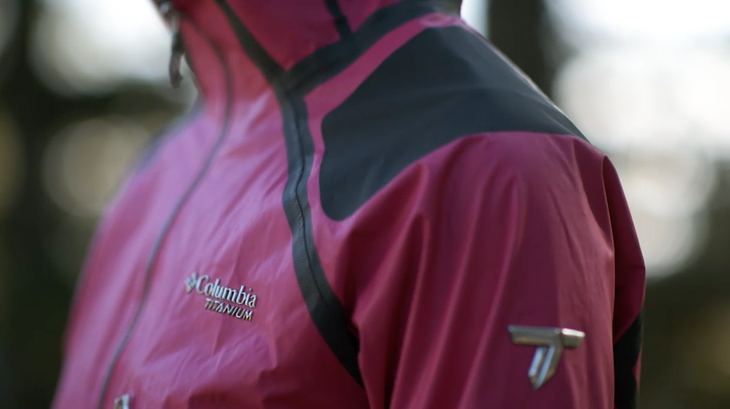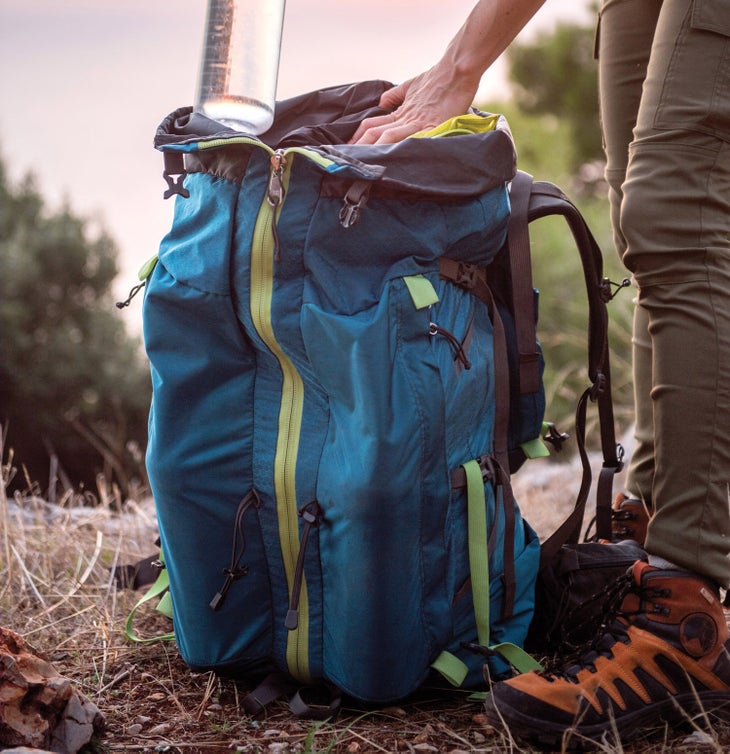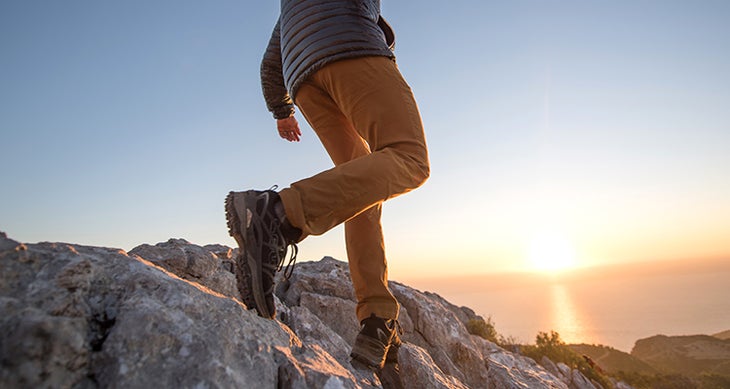Heading out the door? Read this article on the new Outside+ app available now on iOS devices for members! Download the app.
Columbia Outdry Ex Diamond

Hard truth: Even the best hard shells have a weakness. Eventually, the durable water repellent (DWR) on the fabric’s exterior deteriorates. Instead of beading off the surface, water soaks in. And while the fabric doesn’t actually leak—you’re still protected by a waterproof/ breathable membrane—you’ll feel chilled, clammy, and generally uncomfortable until you take steps to revive the chemical DWR treatment.
Not so for the EX Diamond. Columbia’s new OutDry Extreme technology solves the problem of disappearing DWR by skipping the DWR altogether. How? The shell’s waterproof/breathable membrane is on the outside, so the surface needs no extra waterproofing (a polymer overlay protects the membrane). It has the durability of a rubber rain slicker without the sweat—testers found the shell plenty breathable. Columbia says the spaces between the overlay’s tiny diamond shapes enhance breathability.
The result: After seven months of testing in pouring rain and wet snow from Alaska to Yellowstone, precip still runs off the Diamond like mercury. And in our controlled laundry test, a typical DWR-treated shell wet out after 12 wash cycles, but water still dripped off the Diamond like it was brand-new. (That’s still true after 22 total cycles, and counting.)
The fabric’s thick, rubbery feel turned off some testers at first, and ultralighters will scoff. But if staying dry and comfortable in the worst weather— without futzing with DWR treatments—is your top priority, this is your jacket. The Diamond (the most technical of 19 new OutDry Extreme styles) features slight stretch, reinforced patches on the shoulders, and a wicking treatment on the interior fabric; get the same OutDry Extreme technology for less with the stripped-down OutDry EX Platinum ($250) or OutDry EX Gold ($150 to $175). $400
Stanley Adventure SS Shot Glass Set

Do you need this set of nesting, stainless-steel sipper cups to enjoy a backcountry beverage? Of course not. Just like no one needs a camp chair or gourmet dark chocolate. But a er using the Shot Glass Set to toast our arrival at campsites from Everest Base Camp to the Turkish coast, we know one thing for sure: You’ll want this particular indulgence. The steel carrying case with a biner-ready, screw-top lid keeps the four cups dirt-free—and makes it more likely you’ll actually pack them and less likely you’ll lose them. Sure, passing the bottle will always work, but these 2-ounce cups have other benefits besides class. You won’t overfill your coffee mug with precious scotch (oops), and you won’t catch a cold from the group ask. Bonus: The cups are unbreakable and dishwasher safe, so they make a good choice for use at home, too. 7 oz. $20
Backpacker’s Pantry Chana Masala

Dehydrated meals have many benefits: low weight, easy prep, no mess. But even the best recipes tend toward the bland end of the flavor spectrum. A er all, campers can always add hot sauce if that’s what they prefer, right? But that’s not the way the best chefs— or foodies—operate. A really great dish should have all the right spices to begin with, and that’s exactly what we found with this chana masala.
Inspired by the traditional dish from India’s Punjab region, the chickpeas and rice pack a avor punch of chili, cumin, coriander, ginger, coconut milk powder, and about a dozen other ingredients. You can really taste all the exotic spices; even testers who usually dump hot sauce on every meal before they taste it pronounced this dish just right. Prep couldn’t be easier: Just add boiling water and wait 15 to 20 minutes. And it’s a bargain to boot: Just over three bucks each for two 410-calorie (13-ounce) servings. 8.9 oz.; vegan, gluten-free. $6.50
Exped Synmat Hyperlite Duo

“I’ve spent years trying to avoid the cold, hard divide that inevitably opens between my pad and my husband’s” one editor says.
“This is the first solution that truly works for weight-conscious backpackers—we actually have less to carry, not more.” The mummy- shaped Duo is 41 inches wide, making it plenty spacious for couples; even friends with separate bags slept on it and reported feeling no closer than when sharing a typical two-person tent. Two separate chambers of vertical baffles and corresponding valves mean each sleeper can customize firmness and move around without disturbing the other. It’s a luxurious 2.8 inches thick, but still as light and compact when packed (Nalgene-size) as many one-person pads, so whoever hauled the Duo never complained. With an R-value of 3.3, it helped us stay warm down to freezing temps in northern Maine. Our only gripes: The waterproof inflation bag/stuff sack (recommended for efficiency) costs an extra $39, and quick deflation takes practice. 1 lb. 12 oz.; 72 x 41.3 x 2.8 inches (packed size is 6.9 x 5.1 $279
Mystery Ranch Sphinx & Mystic

Not that anyone wants to carry 80 pounds. But if you must, do it with this pack. The Sphinx (Mystic is the women’s model) uses a suspension that’s both stiff for support and flexible for comfort. Two vertical stays are made of fiberglass, which flexes better than aluminum. They’re stabilized by a horizontal carbon-fiber crossbar, which maintains tension so the frame only flexes about 15 to 20 degrees—in sync with how your body moves. “The pack snugged to my lumbar and hips and transferred weight so well that it made a 60-pound load feel like a weekend pack,” says one editor. Great fit is also key, thanks to multiple harness sizes, a shaped hipbelt that spreads the load comfortably, and a Velcro flap that lets you fine-tune torso length.
Durability is also top-notch, which should be no surprise, given this pack’s roots. Mystery Ranch was founded by Dana Gleason, who earned a reputation for building last-forever packs at his previous company, Dana Designs. Turns out it’s in the blood: Gleason’s son, Dana III, designed the Sphinx with a 210-denier nylon fabric that’s used by the military. “It even withstood crampon abuse,” said one tester after a weeklong climbing trip in Montana’s Beartooth Mountains.
The pack also scored top marks for organization. Two vertical “torpedo” pockets provide easy access to essentials, and a long center zip lets you splay open the top-loader. $299
Mountain Hardwear AP Pants

We love the trail-to-town trend, with a slew of brands making technical apparel that you can wear without looking like an Everest guide. Who doesn’t want more versatile clothing? The only problem is that backcountry duds often get dumbed down for the frontcountry. Not so with the AP Pants.
For starters, they’re amazingly tough for the weight.“My buddy ripped his technical hiking pants in Escalante’s cheese grater slot canyons, but even after multiple days of scrambling, mine were unblemished,” says one tester, and this was after he’d already worn the pants for months of testing, everywhere from the Canadian Rockies to the Turkish coast. Credit the fabric’s comfortable blend of cotton and nylon (yes, cotton; we found the fabric did fine in light rain, but these pants aren’t the choice for heavy precip). A dash of elastane adds stretch, so we never felt restricted while high-stepping over canyon chockstones. The elastane also helps the pants retain their shape, even after we wore them for a week straight.
The overall design is clean—take the minimal detailing on the rear pockets, for example—and the cut is trim. Caveat: Some testers found the material too warm for temperatures above 80°F. $90
Columbia Featherweight Hike Long Sleeve Shirt

On an 18-day trip in the Colombian Amazon, our tester wanted several things from his shirt: It had to be light and packable, of course, and fast to dry, with good sun protection and big-trip durability. That’s a lot to ask from any garment, so it’s no surprise he was skeptical when he picked up the Featherweight. It’s so light you’d think it would shred on the first close encounter with a branch. But it delivered, on the Amazon and on many subsequent trips, thanks to nylon fabric that pairs a lower denier with a higher thread count, providing maximum strength for the weight.
Thru-hikers will swoon over the minimalist design—even the TPU buttons are thinner and lighter than standard plastic ones—but this shirt is not featureless. The zippered chest security pocket is large enough for a passport, and the flip-up collar provides good neck protection. Bonus: The antibacterial treatment kept the shirt funk-free for three days at a time. Fit is relaxed but not baggy. $100
Patagonia Merino Air

First impression: This top looks way too good to be a technical performance piece. Second impression: This top works way too well on the trail to be an everyday piece. So much for impressions.
After nearly three months of testing, our staff was fighting over our samples because this airy, wool/Capilene top proved so comfortable in such a wide range of conditions and circumstances, from winter ski touring to summer backpacking to dinner on the town.
The secret behind the fabric: Patagonia created a new process that blasts the fibers with air as they spin, creating more loft and thus more insulating value. “On a chilly night on the Turkish coast, everyone else was snuggling into their puffies but I felt warm and comfortable in just the Merino Air crew over a baselayer,” one tester says. The blended fabric even looks different: It’s textured with an intricate zigzag weave that resembles a fine, hand-knit sweater. It’s soft against the skin, extremely stretchy, and works equally well as a base- or midlayer.
It proved ultrabreathable, too, thanks to the gridded exterior that promotes airflow. Another happy result of that open weave: Stink has nowhere to hide. Combined with wool’s natural odor resistance, this keeps the sweater uncommonly fresh. Five days into our Turkey trip, we couldn’t detect any funk, not even when we sniffed each other’s armpits (ah, the glories of gear testing).
Merino Air fabric comes in a crew and scuba-style hoody, as well as bottoms. Some of us loved the crew because it was cooler and less bulky around the neck, but the hoody had devout fans as well. “It stayed on so well and made the perfect sleeping hat,” says one tester. $129-149
F-Stop Tilopa and Sukha

There are backpacking packs and there are camera packs, but the 50-liter Tilopa and 70-liter Sukha are the only ones we’ve seen that do both equally well. “I’ve taken my F-stops on assignment everywhere from Nepal to Peru to Jordan, and because they carry big loads and provide quick access to my camera, there’s nothing else I’d use,” says one of our photographers. A U-shaped panel opens the entire back side to provide access to the removable Internal Camera Unit (ICU sold separately, $45-$99 depending on size). ICUs accommodate everything from full-size DSLRs with fast telephoto zooms to packable, mirrorless cameras with pancake lenses.
The 5⁄8-inch-thick hipbelt and shoulder straps are padded just enough to handle heavy loads and high-mileage days. “People forget that camera equipment alone can weigh more than 20 pounds, so the 50-pounder I carried on the Choquequirao Trek in Peru was a pretty standard weight,” our tester says. “My quads hated it, but the pack’s suspension handled it like a champ.” The fixed torso size fit all of our testers between 5’7″ and 6′.
Assuming you’re taking one camera body, a couple of lenses, and a few other camera-related sundries, the Tilopa works best for up to three-day trips, and the Sukha for anything longer. The ripstop nylon packbag is coated with a PU film to keep gear dry. We hiked in a surprise autumn snowstorm near Banff National Park, and even with several hours of heavy, wet snowfall on the pack, the contents stayed dry. At $299, the Sukha will cost you a few more bucks than its smaller sibling. $259
MSR Guardian Purifier

Let’s say you treat 100 liters of water a year in the backcountry. That’s a lot—at least 25 days of backpacking, in most conditions. Now let’s say you have a partner, and you filter water for him or her, too. So 200 liters a year. At that rate, the Guardian will last 50 years with zero cleaning.
We were skeptical about MSR’s claims for the Guardian. Normally we try to avoid clogging water filters at all costs. When gunky water gums up some filters, they’re done, and even models that can be cleaned are a hassle to maintain when water is really bad. But during trips on which we pumped some 1,000 liters, from the silty Colorado River to Turkish ponds filled with moss, mud, and goat poop, we couldn’t get the Guardian to clog. How’s it work? With every stroke of the pump, 10 percent of the water backflushes the filter, so it’s self-cleaning. We never detected any slowing of the flow (it’s fast, about 2 liters per minute). “The lever handle is way easier to use than traditional pump style handles,” a tester says.
The hollow-fiber filter is also unusual in two other ways: It eliminates viruses in addition to other pathogens (rare for filters); and, according to MSR, it can withstand freezing temperatures (down to 0°F) without damage. Credit that coldproofing to the filter’s unique physical and chemical makeup (in other words, it’s proprietary). There are certainly lighter, more compact, and cheaper options available, but if you want to clean bottle after bottle of the world’s gunkiest water, this is your filter. 1 lb. 1 oz. $350
Editors’ Choice Gold Award
Vasque Skywalk GTX

When Vasque launched the original Skywalk in 1984, it was amazingly light for a legit backpacking boot, yet still extremely durable and supportive. Plus, thanks in part to multiple widths, it didn’t fit or feel like a clunky old waffle stomper—endearing it to a generation of hikers. Nevertheless, Vasque discontinued the mid- weight boot after two decades, when the market swung toward fast-and-light footwear.
Now the Skywalks are back with the same outward design— and now retro look—but upgraded innards. Made with rough-out leather (full-grain leather with the rough side facing out, enhancing durability) and nylon, with a deep- lugged sole, these waterproof boots are much burlier than they appear. In fact, don’t expect to just take these out of the box and start hiking. As with the originals, it took us about two weeks of break-in before they started to conform to our feet. But once they did, we fell in love all over again.
The svelte profile of the boot felt nimble when we scrambled over sea-slicked rocks along the southern coast of Turkey. Yet the stiff , strong materials—like the midsole made of PU with a TPU protection plate, which shaves weight from the original steel shank—protected our feet in rough terrain. “I didn’t have to tiptoe on sharp rocks, like some of my companions who were wearing lightweight shoes,” says one tester.
Rather than the soft foam padding found in many boots, the Skywalks are firm and stiff around the ankle to prevent rolls. Fit works for most feet, thanks to medium and wide sizes for both men and women. And while they’re no longer light for the category, they’re still more nimble than we expected given the support and durability. 3 lbs. 6 oz. (men’s 11); $200